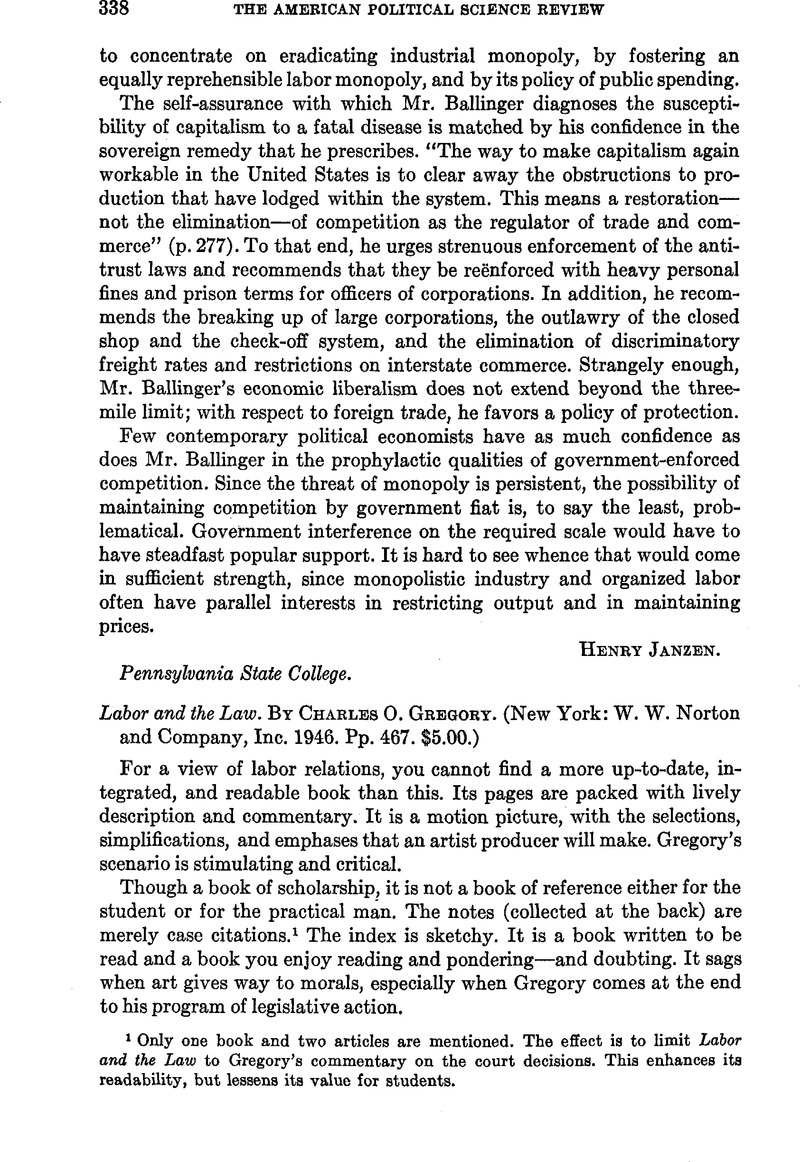No CrossRef data available.
Article contents
Labor and the Law. By Charles O. Gregory. (New York: W. W. Norton and Company, Inc.1946. Pp. 467. $5.00.)
Published online by Cambridge University Press: 01 August 2014
Abstract

- Type
- Book Reviews and Notices
- Information
- Copyright
- Copyright © American Political Science Association 1947
References
1 Only one book and two articles are mentioned. The effect is to limit Labor and the Law to Gregory's commentary on the court decisions. This enhances its readability, but lessens its value for students.
2 His hostility to change of law by decision is frequently stated, e.g., p. 91 (common law), p. 98 (equity), p. 349 (constitutional law).
3 The House of Lords Trilogy (p. 46); the civil rights doctrine (p. 82); pink tea picketing (p. 172). The Supreme Court has done unions “a real disservice in vesting them with the worst curse of modern times—too much power.” Unless Congress provides controls over that power, “the grapes of wrath will ferment until the whole keg blows up. And the wine that spills may be bitter to the taste” (p. 288).
4 221 U.S. 418 (1911). But contrary to the author's allegation (pp. 172, 338, 345), this doctrine was not relied on in American Steel Foundries v. Tri-City Trades Council, 257 U.S. 184 (1921), which fully upheld all peaceful labor action.
5 227 N.Y. (1919).
6 Brotherhood of Carpenters v. Ritters Cafe, 315 U.S. 722 (1942).
7 (a) NLRB v. Va. Electric & Power Co., 314 U.S. 476 (1941). At p. 325 and p. 436, the author forgets that what the Court said was that while it was unfair for the employer to coerce employees by threat of disciplinary consequences of disregarding its advice, “neither the Act nor the Board's order here enjoin the employer from expressing its view on labor policies or problems …. The employer is as free now as ever to take any side it may choose on this controversial issue.”
(b) South Wales Miners' Fed. v. Glamorgan Coal Co. (1905), AC 239, is not a trade-restraint case, as the author implies at p. 430, line 20, but a (dubious) use of the rule against inducing breach of contract.
(c) Lichterman v. Laundry Drivers Union, 204 Minn. 75 (1938), the author at p. 430 transforms from a decision on whether there was a labor dispute (which by parties' stipulation was to determine the judgment) into a decision on the legality of a form of restraint of trade, which it was not.
(d) The anti-racketeering case did not involve the construction of the words quoted at p. 425, line 31. The question was whether the situation fell within the statutory exception of “the payment of wages by a bona fide employer to a bona fide employee.”
(e) The case of Allen Bradley Local is not described at p. 353, line 9, as the note indicates; nor does it seem to be mentioned at all. The opinion in which the author finds a “pathetic” tone is evidently the Hotel Employees Union case.
8 Inland Empire Dist. Council v. Millis, 325 U.S. 697 (1945) is not mentioned at p. 252. The line of cases enforcing collective agreements, beginning in 1922 with Robert F. Wagner's famous decision of Schlesinger v. Quinto, 117 N.Y. Misc. 735, are vaguely and slightlingly alluded to at p. 401, line 22, and p. 409, line 10. Here, as elsewhere, enlightening articles are not mentioned. One on collective agreements named in a note at p. 381 has been superseded by better ones, notably by Lenhoff's, article on “The Present Status of Collective Contracts in the American Legal System,” Mich. Law Rev., Vol. 39, p. 1109 (1941)CrossRefGoogle Scholar.
9 He favors general requirement of arbitration of contract disputes (p. 405). He speculates (p. 423) that: “There might with assurance be undertaken the imposition of some sort of compulsory settlement of bargaining disputes in the utility field, much as has been done with the railroads. This procedure might well be extended to include any vital industry or service without the daily functioning of which the health and safety of the community might be jeopardized.” (He does not discuss methods—or the constitutionality of methods—of carrying this out.) But otherwise he thinks (p. 388) that “in the absence of a paramount national emergency it is almost impossible to justify government assumption of the collective bargaining function.”




